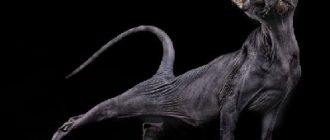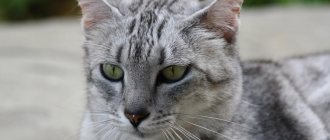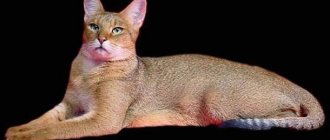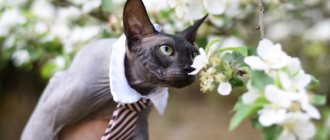Origin of the domesticated form
This domestic form of the jungle cat owes its origin to the ancient Egyptians, who were able to tame the wild cat, and as a result, it helped them hunt and lived in their homes. Subsequently, this breed became popular in Europe and the New World, which was explained by the original appearance, ease of maintenance and friendliness of such pets.
The wild species lives in southern Russia on the coast of the Caspian Sea, in Central Asia and the Middle East. It should be said that in nature there are 9 subspecies of such an animal, many of which are in the Red Book and are protected by law. In nature, the wild jungle cat is extremely cautious and rarely catches the eye of people. He prefers to stay in the densest thickets, hunting rodents and small birds at night. The jungle cat is also nocturnal at home , and mostly sleeps during the day and is active only in the late afternoon.
Hausie coat color and texture
Wool changes its structure significantly depending on the season. In summer it becomes tougher and looser. By winter, chausies become pubescent. The coat becomes thicker and softer. The undercoat becomes denser.
Read here American Bobtail: description, character of the breed, 115 photos of purebred cats and its characteristics
The color completely matches the color of wild relatives. It can fluctuate a bit, but generally has sandy gray undertones.
Chausies may have a tendency to have a monochromatic coat, or exhibit spotting in the form of black spots and sometimes even stripes.
Description of the animal
You can recognize such a jungle cat literally at first sight. The animal has a characteristic almond-shaped eye shape and large erect ears. There is a breed standard that allows you to identify such a pet with maximum accuracy:
- The muzzle is elongated.
- The head is massive.
- The eyes are green or yellow.
- The ears are large in adults and have a tuft.
- There are deceptive eyes on the back of the ears.
- Jungle cats have a short, thin tail that makes up about one-third of their total body length.
- The body is powerful, with a wide chest.
- The paws are long.
- The coat is short, smooth and very thick.
- The main colors are silver, black and ticked tabby.
The jungle cat has pronounced sexual dimorphism . Males are always larger than females and at the withers can reach half a meter in height and 120 centimeters in length. An adult jungle cat weighs about 14 kilograms, and cats are no more than ten.
Description of the breed
The jungle cat, or swamp lynx, has a fairly extensive habitat. Representatives of this species live over vast territories from Asian regions to Indochina and Southwestern China. It is also found from lowland Dagestan to the coast of the Caspian Sea, along the Terek and Kuma rivers. One of the varieties of the breed - the Caucasian reed cat - is listed in the Red Book of Russia.
This is a fairly large cat: its weight ranges from 4 to 16 kg, and the total body length can reach 1.25 m. About a third of this is occupied by an elegant thin tail with several dark rings at the end. Widely spaced large ears are crowned with tassels.
The color of the jungle cat varies depending on its habitat. South Asian representatives have a skin of red and brown colors, while yellowish and gray shades predominate in the fur coats of Central Asian and African cats. In winter, their fur becomes much thicker. The color seems uniform, but in reality it has a very blurry pattern. At the same time, jungle cat kittens are born with pronounced stripes.
As a rule, these cats live in swampy areas (hence another name for the swamp cat) with abundantly growing reeds, reeds and bushes - the color of their skin is ideal for camouflage in this area. These animals prefer not to appear in open areas, only occasionally making cautious forays there. They also do not favor trees, climbing them only if they are hiding from a predator. In the mountains, Hausas do not rise above the 1 km mark because they do not like snow and cold.
Reed cats do not build their homes, using abandoned fox or badger holes, changing their location from time to time. When the time comes for the offspring to be born, the female climbs into the most inaccessible places, arranging a nest there.
These animals swim well, catching fish and even diving for them. By diving under water they get rid of their smell - this is how they differ from domestic cats, who strive to leave their odorous traces everywhere.
South Asian jungle cat
Personality of the pet
By its nature, the jungle cat is a pronounced predator . Even domesticated breeds prefer a nocturnal lifestyle; they are extremely active, tireless and inquisitive. If keeping a wild animal in captivity is a dubious pleasure, then domesticated varieties are distinguished by a calm disposition, they are friendly and extremely interesting to keep.
The so-called Chausie , which is a hybrid of an Abyssinian cat and a jungle cat, are very popular today. In appearance, Chausies are practically indistinguishable from their wild ancestor, but at the same time they are calm and friendly animals that do not cause any difficulties when kept in captivity.
Do not forget also about the need for castration and sterilization of animals . This will not only prolong the life of pets, but will also save the homeowner from any difficulties with an unpleasant odor from an animal that may be marking its territory.
When keeping a jungle cat at home, you should definitely buy a scratching post and a large tray . These animals need open, free space and also love to swim, so you should bathe your pet from time to time.
Character traits and level of intelligence
If your goal is to have a “sofa” pet, feel free to pass by the House cat. This “perpetual motion machine” of the cat family will constantly need your attention, without which it risks becoming sad, falling into melancholy and going wild. What character traits do representatives of this breed have?
- Mobility. Despite their very impressive size, Hausas, with their inexhaustible thirst for research and discovery, remain kittens all their lives. There will be no place left in the house where the cat would not stick its nose - the genes of wild ancestors will not allow this to happen. This beast does not welcome sitting on your hands, but this is even better - its dimensions are quite impressive.
- Learning ability. Jungle cats do not require special measures in matters of training. They are quite smart and efficient, despite their wild nature. It’s easy to teach them to open doors, go to the litter box, etc.
- Need for affection. The domestic jungle cat needs to be pampered with attention and affection. Being forgotten by his masters, he will return to his wild roots and will definitely act out. To avoid this, give your pet a dose of attention and tenderness every day, and your furry companion will be an example of kindness and friendliness.
- Amenability. Cats of this breed easily accept the presence of other tenants, even rodents. Houses will not be jealous and view them as prey, provided that they are given enough attention.
- Curiosity. Swamp cats always keep their ears on top of their heads and instantly respond to any knock, rustle or call. They will definitely run ahead of you to check if everything is okay.
- Water procedures. Jungle cats are one of the few felines who can swim and enjoy swimming. They willingly bathe themselves and will keep company with those who decide to take a bath.
Of course, purebred jungle cats are much more aggressive and capricious than their hybrid relatives, the Houses. If you decide to invite this animal into your home, you must take it in as a kitten at the age of three months, when the cycle of routine vaccinations ends.
Day walk
What kind of care does such a cat need?
- The jungle cat is an active and large animal. Due to the large weight of the cat, it is necessary to regularly check the condition of the pet’s joints.
- He should also get all the necessary vaccinations. Remember that such a reed cat is susceptible to all cat diseases, so you should not neglect vaccination. At the same time, such vaccination must be carried out in full accordance with the recommendations of the veterinarian and not skimp on the quality of the vaccination material. This will protect your pet from various diseases.
- You will also need to regularly comb your pet, washing its ears and cutting out any existing tangles. The coat of this type of cat is not too long, but extremely thick. With proper nutrition, the cat sheds quickly without causing any trouble to the owner.
- The jungle cat quickly gets used to the tray and scratching post at home, so there are no problems with damaged furniture or an unpleasant odor in the apartment.
- Remember that due to the large size of the cat, it is recommended to frequently change the litter in the tray, since such a clean animal will not relieve itself in a dirty and bad-smelling tray.
Jungle cats in the food chain
Little is known about the role of the Hausa in the food chain. They themselves act as hunters and carriers of parasites, both in wildlife and at home.
What does the jungle cat eat?
To get food for itself, the animal can hunt not only at night, but also during the day. The cat sits in ambush for a long time, not betraying its presence in any way, and then suddenly some rodent or unwary bird finds itself in its claws and teeth.
The reed lynx eats both a hare and a reptile with equal pleasure, and does not disdain to catch and eat a domestic chicken or goose. When hunting birds, the animal sneaks for a long time among the thickets of reeds or reeds, and then, having determined by ear where the flock has settled, jumps out and deftly grabs the prey.
Enemies
The original enemies of the wild jungle cat were predators - leopards and wolves. But gradually, with the development of agriculture, humans also joined the list of enemies: he began to exterminate cats for their merciless hunting of poultry. There are no other serious threats to the seal population, but the ones listed above are quite enough to reduce the number.
global $ads_google; //data-ad-slot=”2475549904″ $ads_google = empty($ads_google) ? false : true; ?> if ($ads_google == false) {?>
$ads_google = true; ?> } ?>
Juniper cat nutrition
But the feeding of this type of cat presents certain difficulties. They do not eat porridge and cereals, preferring food of animal origin . Ideally, a proper diet should contain about 200 grams of meat and one live mouse daily.
Once a week, your pet needs to go on a hunger strike , which will be an excellent prevention of obesity. Do not forget also about the need to regularly give the animal minerals and vitamins.
Diseases
Due to the fact that there are wild cats in the Hausi family, this has contributed to the fact that they are not prone to diseases. They have excellent health.
But kittens should still receive the necessary vaccinations against herpesvirus infections, calicivirus and other infections.
You should also regularly do deworming 1 or 2 times a year.
Where and how much to buy a jungle cat
Today in Russia there are no nurseries where you can buy purebred jungle cats. As a result, you either have to order them from Ukraine and European countries or purchase chaus hybrids. When purchasing such a swamp cat, you should pay attention to the availability of documents and the purity of the line from the parents of the kitten you have chosen. The fact is that today quite often hybrids of the Abyssinian breed are offered under the guise of reed cats. The cost of this breed is quite high, which is explained by the rarity of this breed. On average, about 200 thousand rubles are asked for a kitten with a pedigree from good parents.
Features of the reed breed
The jungle cat breed is the largest of the domestic ones. The predator is very active, so if you want to have a living soft toy at home, you should choose a different breed.
Taming and keeping this wild animal at home is completely impossible
A jungle cat kitten should be in the home before it is 3 months old. It's even better to take it early. The kitten will choose an owner whom it will love; its attitude towards others will remain cool. Outsiders will also not be able to establish relationships with the animal.
The peculiarity of these cats is their love for water. All jungle cats love to swim and are able to dive for fish and hunt on the water. Bathing allows them to get rid of the smell; jungle cats do not smell as strongly as regular domestic cats.
When starting a chausie at home, you must remember that the animal requires care and affection. With a lack of attention from humans, the cat “remembers” its wild past and becomes aggressive. Therefore, if it is not possible to spend time with him, kittens of another breed are better suited.
Jungle cats are loyal and faithful, but not tame; they do not like to sit on laps. Families with children should not have them either. Chausies get along easily with other cats and even dogs, as long as they do not show aggressive intentions. But small animals and birds in the house run the risk of becoming their prey.
Cats of this breed are very dexterous, smart and curious. They easily learn to open different doors and remember where things that interest them are. Brave and dexterous, they easily climb to heights, conquering the tallest furniture.
Cat owners give different descriptions of this breed. Some speak of them as kind and obedient animals. The characteristics of others call for caution, because cats can recall their wild nature and cause serious damage to their owners. In any case, when getting a jungle cat, you should not forget that this is not an ordinary pussy, but a serious animal that requires attention and care.
Description of appearance and lifestyle
Acute vision and hearing, and a sensitive nose help a wild cat survive in the natural environment. Thanks to them, the predator can successfully hunt or secretly spy and observe. Koshkorys prefers to hunt at night, but during the day he will not miss an opportunity to go fishing and treat his cubs to fish.
The color of the animal’s fur coat and its shades from gray-sand to brown-yellow depend on the place of residence. And a barely noticeable pattern in the form of dark dots or stripes camouflages the predator among dry reeds in a swamp or in dense vegetation.
Spotted
: Hausa babies have a bright, pronounced pattern on their skin. And with age, all the spots and stripes fade and become barely visible on the gray-brown body of the jungle cat.
In summer, the predator sheds, and when it gets cold, its short fur becomes thicker with a thick, warm undercoat.
The house likes to rest in burrows or secluded places, protected from wind and rain. A cautious animal often changes its beds, especially if it has small kittens.
The bog lynx is twice the size of the usual reddish-gray domestic purr. The body of a savage reaches up to 90 cm in length, but the tail barely reaches 35. A wild adult male weighs from six to fifteen kilograms, and a female weighs a couple of kilograms less.
The Hausa's muzzle is of medium size, round in shape, with a slightly elongated nose. The savage's whisker pads are almost white or an order of magnitude lighter than the general color. They noticeably decorate the cat and do not give away his disguise at all.











